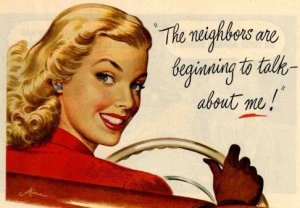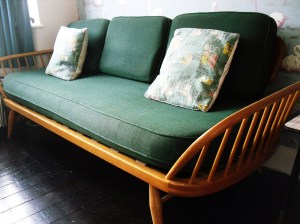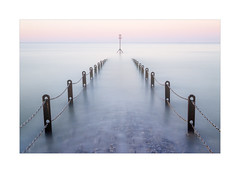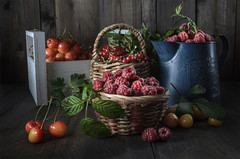Beat the Monday blues by checking out something or someone we love. Here at Your Vintage Life, we feel it is important to share great finds with you all as well as support local business.
So this Monday, I introduce to you the wonderful Betty Bee.
For the Vintage Life magazine readers out there you will recognise Betty for her great D.I.Y projects featured. She arrived on our pages with a clear step by step guide to make a bench from 2 seats. Since then she’s made cake stands, foot stools and even covered a sun lounger.
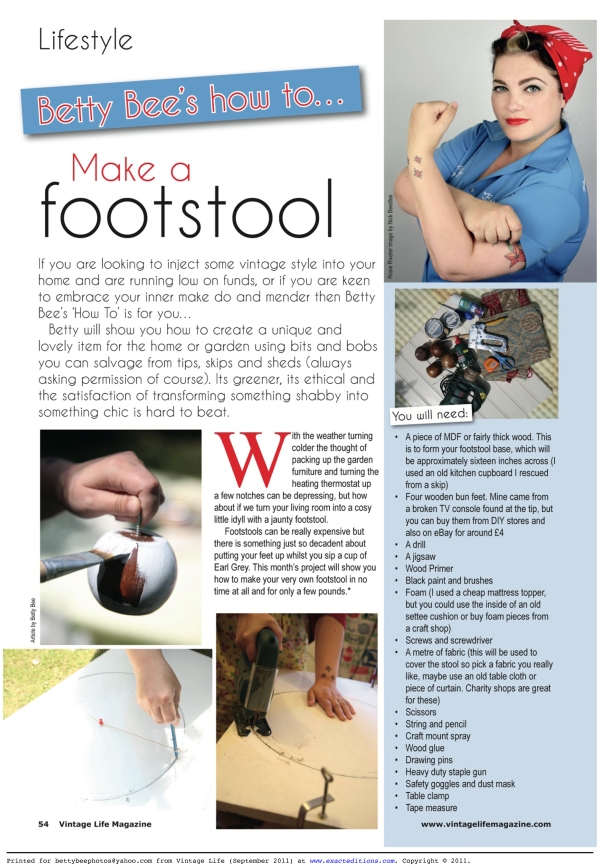 Now a woman who is prepared to get her hands dirty and use a drill is my kinda lady. I remember when my ex husband came to get his stuff after deciding to leave….he came back for his horrid Reebok classics and his white shirts. He shoved them all in a bin bag, then proceeded to the large cupboard at the end of the hall. I started to tremble…not the tools, not the tools went around in my head. Out came the tools (they were his after all) and I actually found myself, out loud, declaring…”NOT THE TOOLS!”…I seem, again, to digress.
Now a woman who is prepared to get her hands dirty and use a drill is my kinda lady. I remember when my ex husband came to get his stuff after deciding to leave….he came back for his horrid Reebok classics and his white shirts. He shoved them all in a bin bag, then proceeded to the large cupboard at the end of the hall. I started to tremble…not the tools, not the tools went around in my head. Out came the tools (they were his after all) and I actually found myself, out loud, declaring…”NOT THE TOOLS!”…I seem, again, to digress.
Back to Betty. She has a load more skills than just brandishing a drill. She is a writer, has an online boutique: Betty Bee Vintage, which sells fab printed T’s designed by herself. She co-runs The Pamper Box fulfilling every girls dream: make-up, hair and cheese cake pin-up photography. She also is a mummy, home maker, baker, blogger and crafter.
 WOW! I hear you say….what doesn’t she do? I hear you say! She has impressed me with her creativity and drive but more importantly she is another vintage lovely who supports others in a positive fashion. She found some time for me last week to answer some of my questions…..
WOW! I hear you say….what doesn’t she do? I hear you say! She has impressed me with her creativity and drive but more importantly she is another vintage lovely who supports others in a positive fashion. She found some time for me last week to answer some of my questions…..
You appear to be involved in lots of exciting projects: can you explain exactly what you do?
I’m fortunate enough to work on a number of lovely projects including vintage inspired wedding photography and cheesecake pin-up photography with my husband at our company Betty Bee Photography (www.bettybee.co.uk) I also design and make a range of vintage inspired homewares and tee shirts for my online boutique www.bettybeevintage.com and run Vintage inspired workshops in hair and make up of the 1940’s and 50’s (www.vintagepamperbox.co.uk). Most people probably know me a writer as I have a regular column in Vintage Life magazine and also work for The Guardian and Creative Crafting.
Phew! This must take some juggling….how do you do it all so well?
Well I never sleep ha ha! N,o I would be lying if I said working across so many projects was easy and now I have a little girl it isn’t any easier but I am ruthlessly organised and rather than jump from job to job I work on certain parts of my business interests on alloted days. I do write every day as I think its vital to discipline yourself and get into the “habit” of writing even a short blog post every morning. Writing is like a muscle, use it or lose it.
 Any advice for someone wanting to get involved with similar projects?
Any advice for someone wanting to get involved with similar projects?
Love what you do and be prepared to work hard. There is no denying that working for somebody else is easier. So much of your time when you are self-employed is spent on boring admin, tax, chasing up payments, finding new suppliers etc which when you are an employee gets done for you, there is however nothing quite as rewarding as receiving good feedback on something you have created all on your own. It’s additive and once the genie is out of the bottle there is no going back.
Your writing for magazines and in your blog has been really well received? Where do you get your ideas?
It’s the old cliché that you hear time and time again but write about what you know. I simply write about my life. If I need or want something I turn it into a craft project which in turn ends up on my blog or in a magazine. Obviously I sometimes get commissioned to write about things I hadn’t automatically thought about but in general I use my own hobbies, interests and life as my muse. I’m too lazy to think up things I think people will like. I just do my own thing and hope people will enjoy the ride.
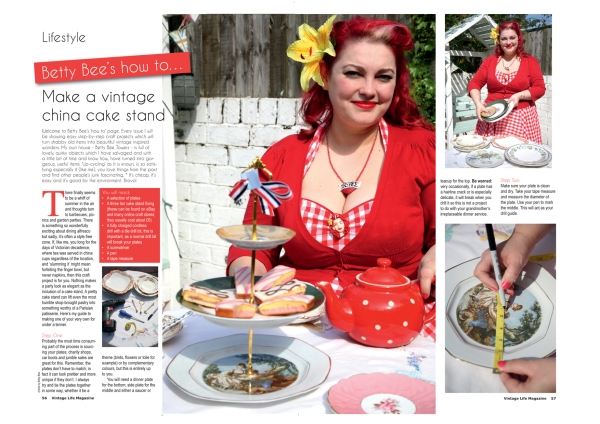 When and why did you get into vintage?
When and why did you get into vintage?
I’ve always been attracted to the 1950’s. My favourite film as child was Grease (I wanted to be Rizzo though, not Sandy) The main attraction has aways been the clothes. I don’t know why as a teenager I was watching films like “Saturday Night, Sunday Morning” and reading “A kind of loving” when my classmates were all loving boy bands. I’ve always walked to the beat of my own drum and loved looking at old magazines, listening to records from the 50’s and 60’s. I am however quite insistent that my take on it has to have a modern twist. I love the past but don’t want to look like I belong at a reenactment event. It’s about making taking vintage items and making them work in modern life.
 What does a typical day look like for Betty Bee?
What does a typical day look like for Betty Bee?
As my work is so varied no one day ever looks the same but there are some constants. I always kick off the day with a cup of earl grey tea, made in a tea pot and drank out of a china cup, I catch up on e-mails, post up my blog and then do at least an hour of writing. Even if I’m not leaving the house I will put my hair in a victory roll and put on my slap. I’m a great believer in the power of red lipstick.After that it’s either a photography session, working on designs for the boutique or dealing with bookings for the Vintage Pamperbox. At 3.15 I down tools and go and pick up my little girl from school and become mum again.
What do you want to be doing in 5 years time?
I’m currently in talks about a number of book projects so I would hope to have a few Betty Bee books gracing Amazon and I would love my blog to be more successful. I would also like to see some of my designs on the high street (did I mention I never dream small ha ha!)
What are you most proud of?
My husband who is so creative and such a huge influence on everything I do (marrying him was the smartest thing I ever did) and my little girl who at five is already brighter and more at ease with herself than I was at 25)
How would your friends describe you?
My friends would, I hope, describe me as creative, hardworking, loyal and gregarious
What’s your most treasured possession?
(Apart from my family of course) it is probably a Garnet heart necklace my dad gave me shortly before he died
What’s your earliest fashion moment?
My earliest fashion moment was thanks to my very fashion forward mother. She dyed my babygros purple. Apparently when I weed it stained my legs blueberry!
Describe your perfect day
My perfect day would be day off with my family. A car boot sale bursting with amazing stuff for tuppence, lunch at the sweet pea cafe in west Kirby (I always have the falafel and chill jam) a walk around the marine lake which is literally on our doorstep and then home to watch some great old kids movie with my little girl (ET is always a big hit)
What would you like to be remembered for?
I would like to be remembered for being a great mum, a great writer and a great laugh.
And finally, Who is Betty Bee?
Betty Bee is a Mother, Writer, Creative and tea belly
So there you have it…an insight into the great Betty Bee. Personally, I would just like to thank the power of Twitter. Through 145 characters I have managed to make friends with fellow vintage gals, Betty being one of them, who have offered laughter, advice and inspiration! If you havent tried it..check it out.
Betty Bee can be found on Facebook, Twitter or at her blog. Go see…..
***********************************************************************************
This Weeks Giveaway: A crochet throw worth £25.
Simply: 1. Sign up to the blog 2. Leave us a comment about the blog 3. Tell your friends through Facebook, Twitter etc so they can join in the vintage fun!
Winner will be drawn on Thursday 6th October x





